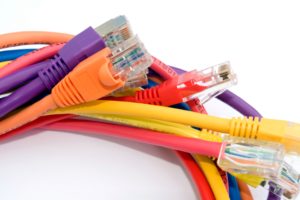Networking and Telecom Glossary of terms
-
Bandwidth:
The maximum amount of data that can be transmitted over a network connection in a given amount of time, usually measured in bits per second (bps) or megabits per second (Mbps).
-
Router:
A networking device that forwards data packets between computer networks. It connects multiple networks together and directs traffic based on IP addresses.
-
Switch:
A networking device that connects devices within a local area network (LAN). It operates at the data link layer of the OSI model and directs data packets to their intended destinations.
-
Modem:
Short for “modulator-demodulator,” a modem is a device that modulates analog signals into digital signals for transmission over a network and demodulates them back into analog signals at the receiving end.
-
IP Address:
An Internet Protocol (IP) address is a numerical label assigned to each device connected to a computer network. It serves as a unique identifier for locating and addressing devices on a network.
-
LAN (Local Area Network):
A LAN is a network that connects devices within a limited geographic area, such as a home, office building, or school. It allows for the sharing of resources and data between connected devices.
-
WAN (Wide Area Network):
A WAN is a network that spans a large geographic area, such as multiple cities or countries. It connects multiple LANs together and enables communication over long distances.
-
Firewall:
A security device or software that monitors and controls incoming and outgoing network traffic based on predetermined security rules. It acts as a barrier between an internal network and external networks to protect against unauthorized access and threats.
-
VPN (Virtual Private Network):
A VPN is a secure network connection that allows users to access a private network over a public network, such as the internet. It provides encryption and anonymity, enabling secure transmission of data between remote locations.
-
DNS (Domain Name System):
The DNS is a system that translates domain names (e.g., www.example.com) into IP addresses. It acts as a directory for the internet, enabling users to access websites by entering domain names instead of IP addresses.
-
Latency:
The time delay between when data is sent and when it is received. Latency is usually measured in milliseconds (ms) and can impact the performance and responsiveness of network applications. Networking and Telecom Glossary of terms
-
Packet:
A unit of data that is transmitted over a network. It contains the payload (actual data) and control information, such as the source and destination IP addresses.
-
Router:
A networking device that forwards data packets between computer networks. It connects multiple networks together and directs traffic based on IP addresses.
-
Ethernet:
A widely used networking technology that defines the standards for the physical and data link layers of the OSI model. It allows for the transmission of data over wired connections using copper or fiber optic cables.
-
VoIP (Voice over Internet Protocol):
VoIP is a technology that enables voice communication over the internet or other IP-based networks. It converts analog voice signals into digital data packets for transmission. Networking and Telecom Glossary of terms
-
4G/5G:
4G and 5G are generations of mobile network technology. 4G (LTE) provides high-speed wireless communication for mobile devices, while 5G offers even faster speeds, lower latency, and support for a larger number of connected devices.
-
ISP (Internet Service Provider):
An ISP is a company that provides internet access to customers. It offers various types of internet connections, such as DSL, cable, fiber, or wireless, and may also provide additional services like email, web hosting, and virtual private networks.
-
PoE (Power over Ethernet):
PoE is a technology that allows for the transmission of electrical power alongside data over Ethernet cables. It eliminates the need for separate power cables, making it convenient for devices like IP cameras, wireless access points, and VoIP phones.
-
MPLS (Multiprotocol Label Switching):
MPLS is a protocol for efficient routing of network traffic. It uses labels to identify packets and determine their forwarding paths, improving the speed and reliability of data transmission in large networks. Networking and Telecom Glossary of terms
-
NAT (Network Address Translation):
NAT is a technique used to translate IP addresses between different networks. It allows multiple devices on a LAN to share a single public IP address, enabling internet access for all devices.
Read more :https://ohiocom.net/dayton-columbus-cincinnati-ohio/network-cabling/network-cabling-cat7-cat-7/



